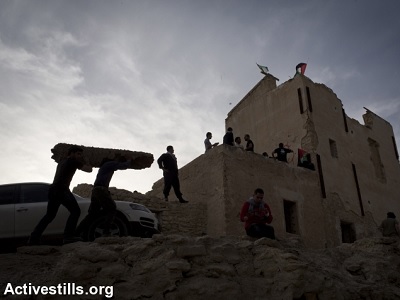
An archbishop, a European Union delegation, the PA minister of agriculture and an Israeli member of Knesset were among the solidarity delegations that visited the protest village of Ein Hijleh on Wednesday as a military siege of the area entered its sixth day.
Israeli forces’ also cut off the water pipe leading to the main well in the protest village of Ein Hijleh three times, leading to minor clashes in the Jordan Valley protest encampment as demonstrators reconnected the pipes.
In addition, Israeli forces continued to refuse to allow the entry of supplies to the village for the sixth day.
Despite the siege, several national icons and international groups visited the village to show support for the protesters, who set up an encampment in the ruins of the ancient Palestinian village Ein Hijleh on Friday in protest against Israeli confiscation policies in the area, continued Jewish settlement construction on occupied land, and recent proposals to annex the Jordan Valley.
Greek Orthodox Archbishop Atallah Hanna visited the village on Wednesday, praising the protesters and saying he will encourage Palestinians to reach the village and support their efforts.
The head and members of the local council of Jericho also visited the village and called upon the ministry of local governments to recognize Ein Hijleh as part of the Jericho district.
The Palestinian Authority minister of agriculture also visited the village and expressed his ministry’s willingness to help repair the land and fix the old homes in the area.
Prime Minister Rami Hamdallah phoned protesters to show his support for them, stressing that although it is the only Palestinian village east of Route 90, it will not be the last due to the efforts of the popular resistance movement.
A delegation representing the European Union also visited the village after receiving an invitation from protesters. They showed their support for the village after protesters briefed them on the circumstances in the Jordan Valley and the threat of Israeli annexation.
Palestinian member of the Israel Knesset Hanna Sweid also visited the village and expressed the support of his party, the Democratic Front for Peace and Equality, for the village.
The protest encampment at Ein Hijleh follows similar efforts by Palestinian protesters in the encampments of Bab al-Shams and Ahfad Younis in early 2013 that were dispersed by Israeli forces.
Jewish settlers frequently raid Palestinian lands and set up illegal outposts across the West Bank, usually uninhibited by Israeli authorities and often supported by Israeli military forces. These outposts are often chosen for their strategic locations between Palestinian villages and atop hills or major roads.
Israeli forces often provide security for the settlers, confiscating nearby Palestinian lands and expanding military presence.
Many of these outposts are eventually developed into permanent settlements, and today nearly 500,000 Israeli Jews live in settlements built across the occupied West Bank and East Jerusalem.
The internationally recognized Palestinian territories of which the West Bank and East Jerusalem form a part have been occupied by the Israeli military since 1967.
(Ma’an – www.maannews.net)





The West-Bank is not a Palestinian land and never was. It is the area that the Jordanian army occupied at 1948 and expelled all the Jews from it.
According to this Palestinian logic if the Jordanian army will occupy Tel-Aviv than Tel-Aviv will be a Palestinian land.